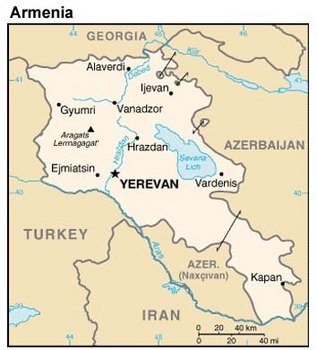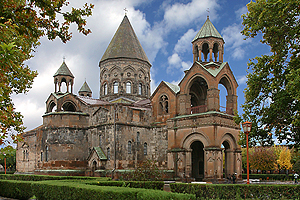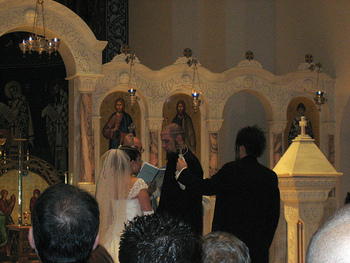Armenian Wedding
Armenia or Hayastan, as its people call it, is a mountainous country in the Caucasus region. Armenia has a population of 3,002,594 (2001). The country has a big diaspora. The biggest Armenian communities exist in Russia, France, Iran, the USA, Georgia, Syria, Lebanon, Argentina, Australia, Canada, Greece, Cyprus, Israel, Poland and Ukraine.
 Map of Armenia
Map of Armenia
More than 93% of Armenians are members of Armenian Apostolic Church. Armenian Apostolic Church was established in the 1st century AD by Thaddeus and Bartholomew who were two of twelve Christ's apostles. They preached Christianity in Armenia between AD 40-60.
The most important church for all Armenians and the headquarters of the Armenian Apostolic Church is The Mother See of Holy Etchmiadzin. The church is located in the city of Etchmiadzin (Ejmiatsin). The church was Built and consecrated by St. Gregory the Illuminator and St. Trdat the Great in AD 303.
 The Mother See of Holy Etchmiadzin
The Mother See of Holy Etchmiadzin
It is a tradition that groom must ask the bride's family for the bride's hand. Armenian do it by holding a meeting of members of both bride's and groom's family. More formal and more common traditional meeting of that nature is called "Khosk-Kap". Less formal meeting called "Khosk-Arnel" is sometimes organized too.
The "Khosk-Kap" is a formal dinner organized in bride's home. Groom, his family (parents, brothers, sisters) but also his grandparents, aunts, uncles and some close friends are invited to come. They bring lovely floral arrangements, chocolate and cognac.
After the formal introduction, everybody is seated and tea is served. This is the time for the eldest member of the groom's family to ask for the bride's hand. After the the bride's family says "yes" people can actually start drinking tea.
If the couple is planning to marry Armenians kind of unite the "Khosk-Kap" and the Engagement reception. In other cases couple can hold both events.
By many, the engagement reception is almost the same as the actual wedding reception. The thing that differs them is the fact that the engagement reception does not include the religious ceremony. But there is a priest present. He blesses the engagement rings and the couple’s plans for marriage.
In the morning of the wedding day there are actually two wedding groups. The one in bride's home and the one in groom's home.
Let's start with the groom's house. The appetizer is served. There is a band playing. The traditional Armenian band is called Sazandar. Its members start performing when the best man arrives.
Red and green ribbons are pinned on clothes of those present there. Several toasts are made. Everyone is dancing.
Groom and members of his party arrive at Bride's home at around noon. They arrive holding several baskets. In these baskets there are the bride’s shoes, garter, purse, jewelry, chocolate and cognac.
The bride then goes to her bridal room to put her wedding gown on. This room and the rest of the house are being decorated on a day before the wedding by bride, her family members and friends. The bride does not put her wedding shoes on. It is done by the closest male member of her family. It can be her brother or some cousin.
There is more. Member of bride's family can take one of the shoes and blackmail everyone by asking a ransom for the shoe. Everything is settled in few minutes. The groom's family pays the ransom.
Shoes are definitely important. All single women write their name on the bottom of bride's shoes. When some of them get married she crosses her name.
The bride circles over heads of all single women with her veil. It is done for luck. The veil is put on bride's head by a married woman. She must be married for many years.
It is a tradition that bride wears a blue charm with an eye. This is the evil-eye charm. Armenians call it “Atchka Ooloonk”.
When the bride is finally ready toasts are made by members of both family. It is a tradition that cognac drank is served in chocolate cups. Bride and groom dance. Everybody joins in. Lot of photographs are made.
The next on the agenda is the ceremony in church. It lasts for about an hour. Each part of the ceremony has special meaning.
After the priest blesses the couple they exchange rings. The right hands of the bride and groom are joined. This is a symbol of couple's unity.
 Armenian wedding
Armenian wedding
The Armenian wedding ceremony reaches its peak in ritual of Crowning. Crowns worn by bride and groom are symbols of their own little kingdom or home. During the crowning bride and groom face each other. The best man stands between them and holds a cross over their heads.
After the crowing there is a blessing of the common cup. The cup has little bit of wine it. It is done in the memory of the marriage at Cana of Galilee where Christ was present.
The wedding ceremony ends when the priest blesses the couple. He ask the Christ to "protect them under the shadow of thy holy and honourable cross in peace".
The final stage of the wedding is the reception. Between 200 and 500 people attend the party. Lot of delicious food is served.